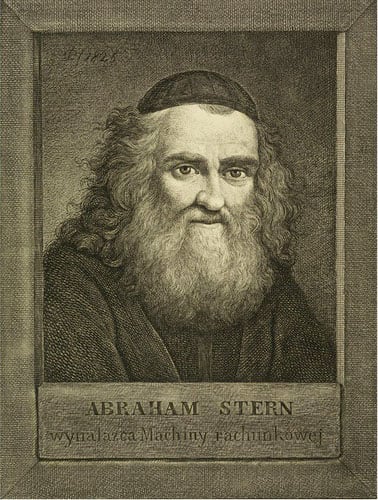- In the new city, Stern studied mathematics and mechanics as well as new languages, including French, German, Latin, and Polish. His first invention was a distance meter which ended up replacing Marinoni’s measurement board.
- Abraham’s mathematical genius enabled him to create mechanical calculators. He also created a new kind of sickle, a horse reaper, and a sawmill.

Who Was Abraham Jakub Stern?
Abraham Jakub Stern (alternatively spelled Avraham Ya’akov Shtern) was a mathematician, translator, mechanical engineer, and a leading figure in the Haskalah. He worked on numerous projects during his life, including agricultural inventions and a mechanical calculator. At the same time, Stern worked to promote Jewish orthodox culture and fought against cultural assimilation of his people. By the time of his death in 1842, he had long won over the respect of his colleagues for his dedication to both academics and preserving Jewish culture.
Early life
Born to a poor Jewish family on December 31 ,1768, Abraham Stern was raised in the town of Hrubieszów, Poland. Hrubieszów had been home to Jewish people from as early as the 1400s, but by the 18th century, Jews were estimated to own around a third of all the buildings and participated in much of the economy.
His mother was Miriam Liba Stern and his father was Menachem Mendal Stern, a clockmaker and one of many Jewish artisans living in Hrubieszów. Abraham also had an older brother named Yehuda Leybush Stern. Thanks to his father, Abraham was initially trained as a watchmaker.
Abraham was a child prodigy in some regards, with an early interest in philosophy, mathematics, and the study of Hebrew books. Menachem Stern took note, toiling away in hopes of providing his son with a good education. His hard work paid off and Abraham Stern eventually caught the eye of Stanisław Staszic, an important Polish official.
Staszic was a Counselor of State of the Duchy of Warsaw living in Hrubieszów and a leading figure in the Polish enlightenment. He remained an important person in Polish political affairs for decades, allowing Stern’s entryway to the public eye and to scientific society. Under Stasicz, Stern was able to move to Warsaw and focus on studying mathematics and mechanics. He was exposed to new languages, such as Latin, French, Polish, and German.
Interestingly, Staszic didn’t think favorably of the Jews and is known for having anti-Semitic sentiments– as a Catholic priest, he worked for years as the spearhead of anti-Semitic political movements in Poland. Despite all that, Staszic saw pure potential in Abraham Stern. He was proven correct with Stern’s first invention: a distance meter. This moving topographic machine was useful for the army and engineers alike, and subsequently it took the place of Marinoni’s measurement board.
Career
Stern’s Calculation Machines and Administrative Work
By 1812, Stern had developed an early iteration of his mechanical calculator. Calculation machines are where Stern thrived, thanks to his background and early interest in mathematics.
Although only able to perform four functions, his first calculator provided a quick and accurate way for accountants to do their job. Needless to say, the machine seemed miraculous at the time, and he was able to show it to Czar Alexander I in 1816. The Czar offered him a pension based on the machine. Later, Stern became the only Jew to join the Royal Society of Friends of Science thanks to the invention. Stern went on to improve his machine by adding the ability to extract roots and take exponents in 1818, after requesting funds from the Czar in 1817.
At the same time as these achievements, Stern wrote poems and was a Hebrew translator. In 1818, he created the curriculum of a rabbinical school in Warsaw and was offered the position of first headmaster (which he declined, feeling that the school was ultimately working toward Jewish secularization).
Stern’s Agricultural Contributions
He may be most well-known for his mechanical calculators, but Abraham Stern invented a number of agricultural devices, too, including thrashing and harvesting machines. Thrashing and harvesting machines existed before Stern, but he did improve the construction of these important tools. For good measure, he created a new type of sickle and a saw mill.
Out of his agricultural inventions, Abraham Stern’s horse reaper– created in 1835– is the most famous. Horse reapers were, as the name implies, devices that cut grain and were pulled by horses. Unfortunately, accidents weren’t uncommon when working with horse reapers, and the results could be tragic. His new horse reaper used a special detachable tongue and brake to eliminate the danger from carriages disconnecting from the horses.
A little known agricultural invention of Stern’s is a machine he built in 1827, which was made to raise cereals. It wasn’t as practical as his other inventions, finding no mainstream use.
What is Abraham Jakub Stern Known For?
Inventor, Mechanic, and Mathematician
Abraham Jakub Stern is most known for his mechanical inventions, especially his accounting machines. Even though he started as a poor Jew living in a town in Poland during the early 1800s, Abraham Stern was able to meet the Czar Alexander I, join the Royal Society of Friends of Science, and progress society. Much of this was thanks to his early interest in academics (particularly Jewish philosophy and mathematics), which caught the eye of an important Polish official.
His inventions include a distance meter, a new kind of sickle and saw mill, three mechanical calculator iterations (each improving on the next), and improvements to a variety of devices. Fundamentally, Abraham Stern was known for his innovative application of mathematics and mechanics.
Jewish Academic, Writer, and Translator
Abraham Stern was also known for his perspectives on Jewish culture and his role in the Haskalah, also called the Jewish enlightenment. Stern contributed to the enlightenment simply by being an inventor and a skilled artisan.
Beyond that, Stern created a curriculum for a rabbinical school opening in Warsaw and was even offered the position of headmaster (which he declined, feeling that it would lead to the dilution of Jewish orthodox). This is one example of Abraham Stern’s steadfast beliefs against the assimilation of Jewish culture and hasidism, which earned him the respect of many of his peers– regardless of if they shared the same belief.
Stern acted as a censor and inspector of Jewish schools while studying and working on his inventions, and to add to the extensive list of Stern’s achievements, he wrote and translated Hebrew literature. In some contexts, his contributions to Jewish culture are seen as equally as important as his mechanical work.
Up Next…
Interested in finding out about other influential individuals who changed our world forever? Read the following articles below:
- Eduard Selling – Complete Biography, History and Inventions: This mathematician and astronomer was known for his calculating machines and his attempts at pension reform in Bavaria. A brief account of his life is provided in this article.
- Wilhelm Schickard – Biography, History and Inventions: Linguist, astronomer, and surveyor, he was also an acquaintance of the great Johann Kepler. Discover more about his remarkable life.
- Jean-Baptiste Schwilgue – Complete Biography, History, and Inventions: The brains behind the Strasbourg Astronomical Clock, he would go on to create others within the city. Yet only one of his works survives him. Find out about this remarkable clock-maker, here.
Abraham Jakub Stern: Marriage, Divorce, Children, and Personal Life
Net Worth
Despite his impressive inventions and his participation in the Haskalah, Abraham Stern lived in poverty. He was held afloat by patrons and, occasionally, by friends.
Marriage
Abraham Stern’s final and only known wife was Shaindla Lipshitz (alternatively spelled Szajndla Lipsyzc). Little is known about her. She did, however, bear two children after their marriage in 1823. Shaindla was 20 years old at the time of marriage and was the daughter of Moshka and Etli Lipshitz.
Divorce
Stern was married multiple times, although only his last wife is known. It’s uncertain how many wives he had before Shaindla, but he did have children from those prior marriages.
Children
Abraham Stern had at least nine children. Three of these were daughters he had with Shaindla Lipshitz: Esther, Idla, and Sara Gitel. His other children were from earlier marriages and were named Ber, Izaak, Eliezer, Jacob, Hanoch, and Rachel.
Abraham Jakub Stern Awards and Achievements
Admission to Royal Society of Friends of Science
Abraham Stern was eventually admitted to the Royal Society of Friends of Science after his successful upgrades to his accounting machines. He is the only Jew to have ever been bestowed the honor of being part of this group.
Abraham Jakub Stern Published Works and Books
Rinnah u-Tefillah
When Nicholas I was crowned, Abraham Stern wrote an ode dedicated to Nicholas I and the event. It was first written in Hebrew before being translated into Polish by J. Gluegenberg.
Shirim from Shire Musar Haskel Collection
As an orthodox Jew and academic, Stern wrote Hebrew poems known as Shirim. Some of them are included in the Shire Musar Haskel Collection by Alexander Gazon.
Treatise on an Arithmetic Machine
Abraham Stern wrote this treatise detailing the mechanics of his accounting machine. It was intended for the Warsaw Scientific Society before presenting the machine to them.
Abraham Jakub Stern Quotes
- “Experience teaches us that many things that initially were luxurious only because of having been used by a small number of people”
- “From all this ensues, that when in the mankind a number of needs increases, then by this very thing, the ingenuity in methods and means to meet these needs has to multiply”
FAQs
Who was Abraham Jakub Stern?
Abraham Jakub Stern was an inventor and Polish Jew from the Jewish Enlightenment era. Born in 1768, he made many contributions to agriculture and accounting (amongst other things) through his inventions. He was also known as a spokesperson and activist against Hasidism, in support of orthodox culture. Stern made multiple attempts over his lifetime to preserve Jewish literature and belief.
What did Abraham Jakub Stern invent?
Abraham Stern invented multiple machines over the course of his life. He is most famous for his mechanical calculators, but he also invented a measuring device, a safer horse reaper, and a number of other agricultural devices.
FACTS BOX
| Full name | Abraham Jakub Stern |
| Birthdate (month, date, year) | December 31, 1768 |
| Death date (month, date, year) | February 3, 1842 |
| Net Worth | N/A |
| Awards | N/A |
| Children | 9 (Ber, Izaak, Eliezer, Jacob, Hanoch, Rachel, Sara Gitel, Esther, and Idla) |
| Nationality | Polish |
| Place of Birth | Hrubieszów, Lublin, Poland |
| Fields of expertise | Mathematics, mechanical engineering, and Jewish philosophy |
| Institutions | Committee for Jewish Affairs, Royal Society of the Friends of Science, Polish Academy of Sciences |
| Notable Contributions | Protected Jewish literature and culture, invented mechanical calculator, threshing machine, horse reaper, and geodetic rangefinder |
Want to Retire Early? Start Here (Sponsor)
Want retirement to come a few years earlier than you’d planned? Or are you ready to retire now, but want an extra set of eyes on your finances?
Now you can speak with up to 3 financial experts in your area for FREE. By simply clicking here you can begin to match with financial professionals who can help you build your plan to retire early. And the best part? The first conversation with them is free.
Click here to match with up to 3 financial pros who would be excited to help you make financial decisions.
The image featured at the top of this post is ©G-Stock Studio/Shutterstock.com.
